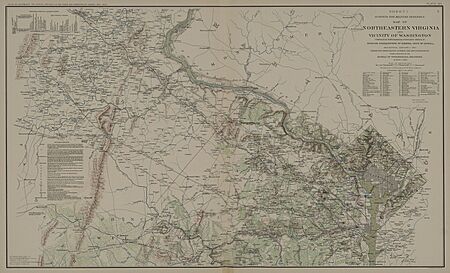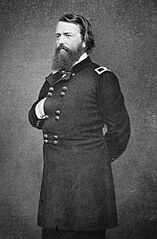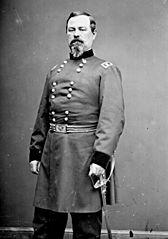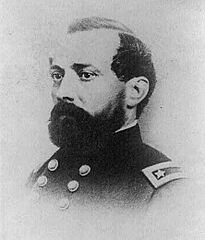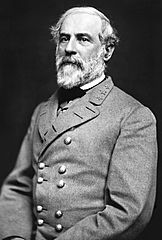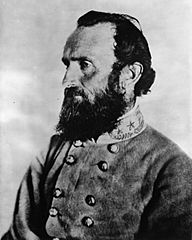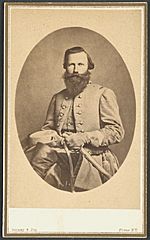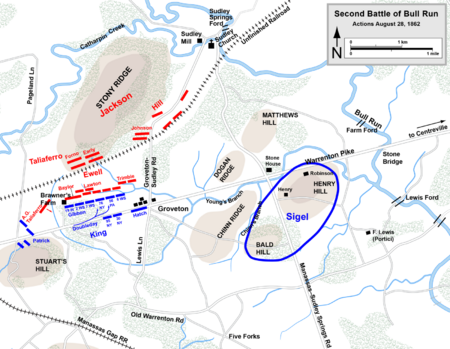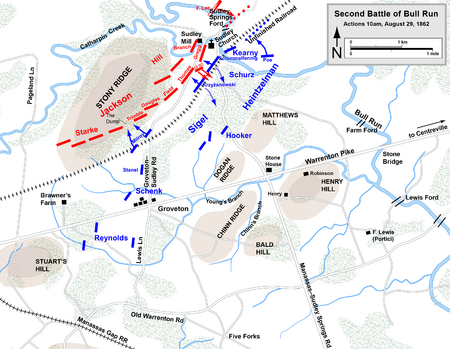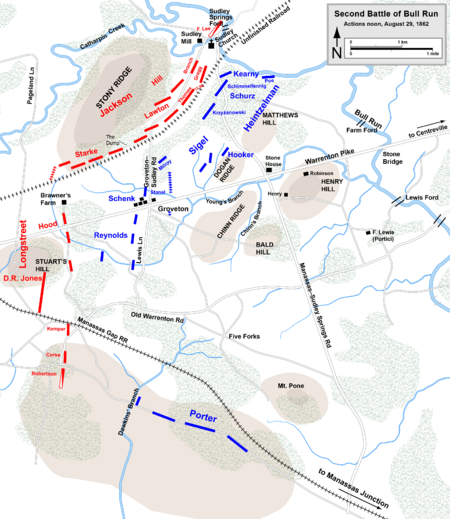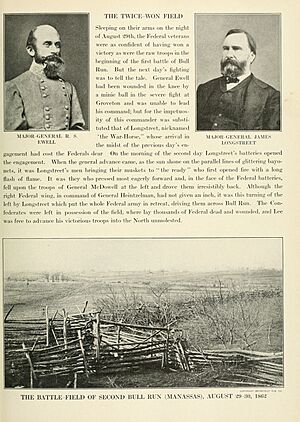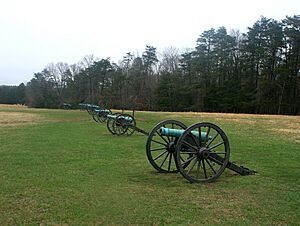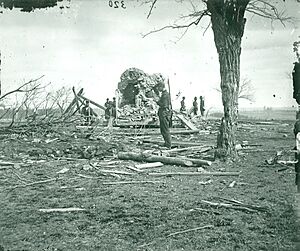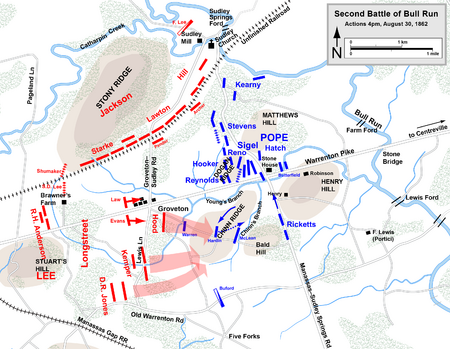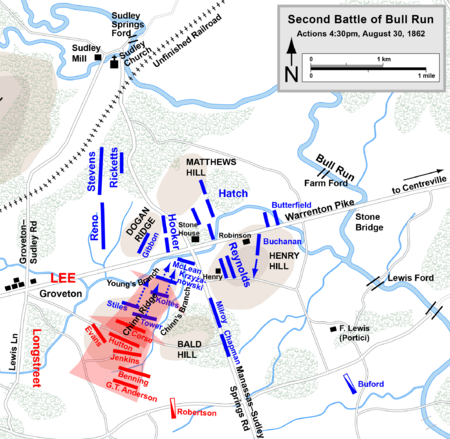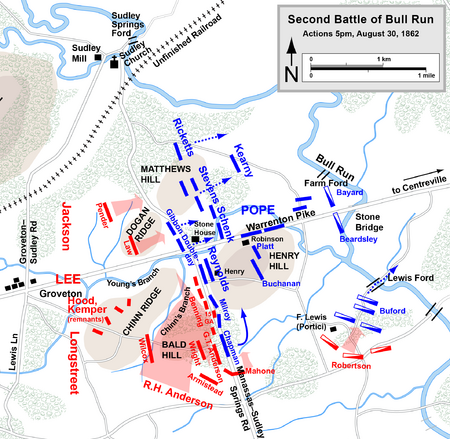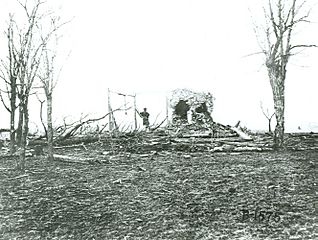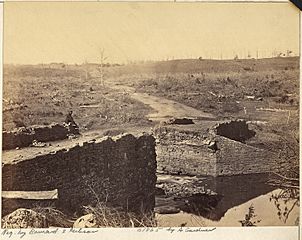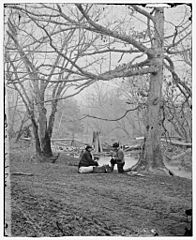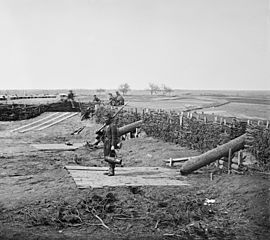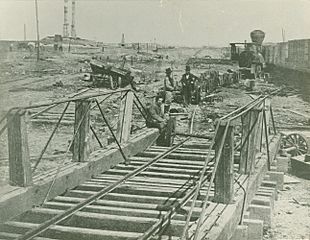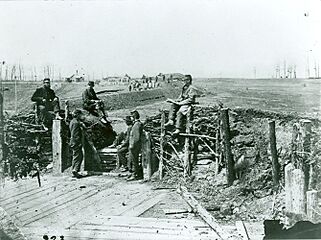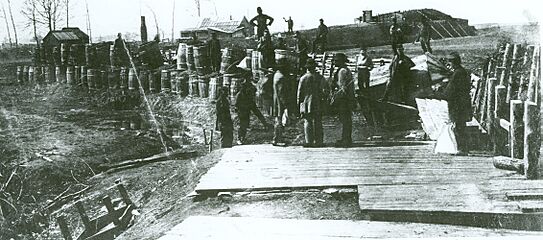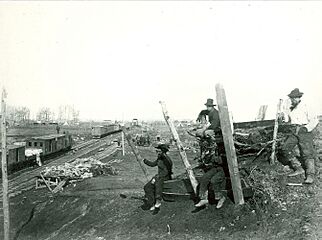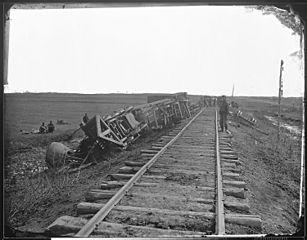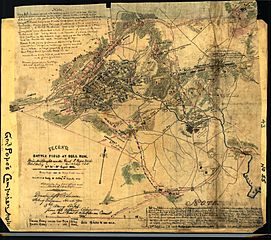Second Battle of Bull Run facts for kids
Quick facts for kids Second Battle of Bull Run(Battle of Second Manassas) |
|||||||
|---|---|---|---|---|---|---|---|
| Part of the American Civil War | |||||||
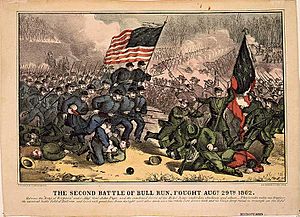 Second Battle of Bull Run, fought Augt. 30th 1862, 1860s lithograph by Currier and Ives |
|||||||
|
|||||||
| Belligerents | |||||||
| Commanders and leaders | |||||||
| Units involved | |||||||
|
|||||||
| Strength | |||||||
|
77,000 (estimated):
|
50,000 | ||||||
| Casualties and losses | |||||||
| 14,462
1,747 killed
8,452 wounded 4,263 captured/missing |
7,298
1,096 killed
6,202 wounded |
||||||
The Second Battle of Bull Run, also called the Battle of Second Manassas, was a major fight in the American Civil War. It happened from August 28 to 30, 1862, in Prince William County, Virginia. This battle was the big finish of the Northern Virginia Campaign.
Confederate General Robert E. Lee led his Army of Northern Virginia against Union Major General John Pope's Army of Virginia. This battle was much bigger than the First Battle of Bull Run (First Manassas), which happened on the same ground in 1861.
Before the main battle, Confederate Major General Stonewall Jackson marched his troops around the Union army. He captured the Union supply base at Manassas Junction. This move threatened Pope's way of getting supplies from Washington, D.C.. Jackson then moved a few miles northwest. He set up strong hidden defenses on Stony Ridge. He waited for the rest of Lee's army, led by Major General James Longstreet, to arrive.
On August 28, Jackson attacked a Union group near Gainesville. This fight, known as Brawner's Farm, was a draw. But it got Pope's attention. That same day, Longstreet's troops broke through Union defenses at the Battle of Thoroughfare Gap. They then moved closer to the battlefield.
Pope thought he had Jackson trapped. He gathered most of his army to attack Jackson. On August 29, Pope launched many attacks against Jackson's lines along an unfinished railroad track. The attacks failed, and both sides lost many soldiers. Longstreet's troops arrived at noon and joined Jackson's right side.
On August 30, Pope attacked again, not knowing Longstreet was there. When Confederate cannons stopped a Union attack, Longstreet's 25,000 soldiers launched a huge counterattack. This was the biggest group attack of the war. The Union army's left side was crushed. They were pushed back to Bull Run. A strong Union rear guard helped prevent a total disaster like the First Manassas. But Pope's retreat to Centreville was still very fast.
Winning this battle made General Lee confident. It led him to start his next move, the Maryland Campaign.
Contents
Why the Battle Happened
The Situation Before the Fight
After Union Major General George B. McClellan's Peninsula Campaign failed in June 1862, President Abraham Lincoln chose John Pope to lead the new Army of Virginia. Pope had done well in the western part of the war. Lincoln wanted a general who would fight more aggressively than McClellan.
Pope's main jobs were to protect Washington and the Shenandoah Valley. He also needed to draw Confederate forces away from McClellan. He did this by moving towards Gordonsville. General Lee knew McClellan was no longer a threat on the Virginia Peninsula. So, he moved Jackson's troops to Gordonsville. This blocked Pope and protected an important railroad.
Lee had bigger plans. The Union army was split between McClellan and Pope. They were far apart. Lee saw a chance to defeat Pope's army first. Then he would deal with McClellan. He sent Major General A.P. Hill and 12,000 men to join Jackson.
First Moves of the Campaign
On August 3, Union General-in-Chief Henry Halleck told McClellan to bring his army back to Northern Virginia. This was to help Pope. McClellan disagreed and did not start moving until August 14.
On August 9, Union General Nathaniel Banks's troops attacked Jackson at the Battle of Cedar Mountain. Banks gained an early lead. But a Confederate counterattack pushed Banks back. Jackson's advance stopped. He learned that all of Pope's troops were together. This ruined his plan to defeat them one by one. Jackson stayed until August 12, then went back to Gordonsville. On August 13, Lee sent Longstreet to help Jackson.
Getting Ready for Battle
From August 22 to 25, the two armies had small fights along the Rappahannock River. Heavy rains made the river too high for Lee to cross. By this time, more Union troops from McClellan's army were arriving. Lee's new plan was to send Jackson and Stuart with half the army on a long march. They would cut Pope's supply line, the Orange & Alexandria Railroad. This would force Pope to retreat. Lee hoped to defeat Pope while he was moving and vulnerable. Jackson left on August 25.
On the evening of August 26, Jackson's troops went around Pope's right side. They captured and destroyed the huge Union supply base at Manassas Junction. This surprise move forced Pope to quickly retreat from the Rappahannock. During the night of August 27–28, Jackson marched his troops north. They went to the First Bull Run battlefield. He took a strong position behind an unfinished railroad track. This spot was good for defense. The thick woods hid the Confederates. They could still see the Warrenton Turnpike, where Union troops would likely move. There were also good roads for Longstreet to join Jackson. The unfinished railroad track offered ready-made trenches.
In the Battle of Thoroughfare Gap on August 28, Longstreet's troops broke through light Union resistance. They marched through the gap to join Jackson. This action was very important. It allowed Lee's two army parts to come together on the Manassas battlefield.
The Armies Fighting
Union Forces
| Key Union Commanders |
|---|
|
General Pope's Army of Virginia had about 51,000 men. It was split into three army corps. Later, parts of General McClellan's Army of the Potomac joined Pope. This made his total strength about 77,000 men.
Confederate Forces
| Key Confederate Commanders |
|---|
|
On the Confederate side, General Robert E. Lee's Army of Northern Virginia had about 55,000 men. It was organized into two main parts. Major General James Longstreet led the Right Wing. Major General Stonewall Jackson led the Left Wing.
It is hard to know the exact number of soldiers in both armies. Reports give different figures. The Confederate army had about 50,000 fighting men. The Union army had about 63,000 men actually fighting in the battle.
The Battle Unfolds
August 28: Brawner's Farm Fight
The Second Battle of Bull Run started on August 28. A Union group was moving along the Warrenton Turnpike. They were near the John Brawner family farm, just outside Gainesville. Confederate General Jackson saw them. He was happy to hear that Longstreet's men were coming to join him.
Jackson worried that Pope might be retreating. He decided to attack. Around 6:30 p.m., Confederate cannons began firing. They hit a part of the Union column. This was John Gibbon's Black Hat Brigade. The cannon fire stopped the Union group.
The 2nd Wisconsin Infantry, with 430 men, advanced quietly. They came out of the woods onto John Brawner's farm. They met 800 men of the famous Stonewall Brigade. The Confederates fired a heavy volley. The 2nd Wisconsin fired back. Both sides fought fiercely for over two hours. The battle lines stayed very close. It was a stand-up fight with little cover.
Jackson described the fight as "fierce and bloody." Gibbon added more of his troops. Jackson sent in more Confederate regiments. The fight ended around 9 p.m. Gibbon's men slowly retreated while still firing. The fight was a draw, but both sides lost many men. Over 1,150 Union soldiers and 1,250 Confederate soldiers were killed or wounded.
Jackson had not won a clear victory. But he had achieved his goal. He had gotten John Pope's attention. Pope wrongly thought Jackson was retreating. He believed he had Jackson "trapped." Pope wanted to capture Jackson before Longstreet could reinforce him.
Union generals decided to retreat south to Manassas Junction. They knew Jackson had many more men. Pope then ordered his officers to surround Jackson and attack him in the morning. But Jackson was not where Pope thought. Pope's own troops were also not where he expected. Jackson was dug in and waiting for Longstreet. Pope refused to believe Longstreet was nearby.
August 29: Jackson Defends Stony Ridge
Jackson had started the fight at Brawner's Farm to hold Pope. He waited for Longstreet to arrive. Longstreet's 25,000 men began marching at 6 a.m. on August 29. Jackson sent cavalry to guide Longstreet's troops. Jackson also set up his defenses. He placed 20,000 men along a 3,000-yard line. This was south of Stony Ridge.
Jackson's position was strong. It was along an unfinished railroad track. Some parts of the track were good for defense. But the thick woods made it hard to use cannons. Union cavalry tried to go around Jackson's left side. But Confederate cavalry stopped them.
At dawn on the 29th, Pope learned that his generals had retreated south. Pope was still sure Jackson was trapped. He thought he would win a big victory. But Pope's attack plans for August 29 turned into a simple frontal attack. Only Sigel's corps was in position that morning. Sigel's I Corps was considered one of the weakest Union groups. Many of its soldiers were German immigrants. They spoke little English.
Sigel's attack against A.P. Hill's division began around 7 a.m. The Confederates mostly stayed in their defensive positions. They took the Union blows. Then they launched strong counterattacks. This was similar to how Jackson would fight later at the Battle of Antietam. Union brigades fought hard. They had hand-to-hand combat in the woods. Some Union troops found a weak spot in the Confederate line. But they were quickly pushed back. Many Union soldiers were killed or wounded.
By 1 p.m., more Union troops arrived. Pope also came to the battlefield. He expected to see a victory. Instead, he found that Sigel's attack had failed. Pope thought about retreating. But he worried about what people would say. Then he got a message. It said more Union troops were coming. So Pope decided to attack Jackson's center.
By this time, Longstreet's first troops were in place. They were on Jackson's right side. General Lee wanted to attack the Union left. But Longstreet saw that Union troops stretched past his line. He argued against attacking right then. Lee agreed when his cavalry reported that the Union force was strong.
Pope ordered four separate attacks on Jackson's front. He wanted to distract the Confederates. He still thought another Union group would attack Jackson's right side. Union General Cuvier Grover's brigade attacked at 3 p.m. They charged at a Confederate brigade. Grover's men reached the railroad track. They fired at close range and charged with bayonets. The Confederates were surprised and fell back. Fierce hand-to-hand fighting followed. More Confederate troops arrived. They hit Grover's brigade from the side. Grover's men ran away, losing many soldiers.
Other Union attacks also failed. Confederate counterattacks pushed the Union troops back. Union cannons helped stop the Confederate advances. On the Confederate right, Longstreet saw Union troops moving away. This made Lee want to attack again. But Longstreet again argued it was too late in the day. Lee agreed.
At 4:30 p.m., Pope finally sent a clear order to attack. But the message was delayed. Pope ordered another attack on Jackson's far left side. This was to put pressure on both ends of the Confederate line. At 5 p.m., Union brigades attacked A.P. Hill's tired division. The Confederates were almost out of ammunition. They began to fall back. But more Confederate troops counterattacked. They pushed the Union division back.
On the Confederate right, Longstreet's division arrived. They pushed Union troops back. As night fell, Longstreet's troops pulled back from their exposed position. Pope thought this meant the enemy was retreating. He ordered more attacks for August 30. This was a bad decision. Pope no longer had more soldiers than the Confederates. He should have retreated across Bull Run. He could have joined McClellan's army, which had 25,000 men nearby.
That evening, Pope sent a report. He said the day's fighting was "severe." He thought he had lost 7,000–8,000 men. He guessed Confederate losses were twice that. This was very wrong. Jackson had mostly fought a defensive battle.
Some people criticized Union General George B. McClellan. Two of his army corps had arrived in Alexandria. But McClellan would not let them go to Manassas. He said they did not have enough support. His opponents said he was trying to make Pope fail. McClellan even wrote that Pope would be "badly thrashed."
August 30: Longstreet's Big Attack and Union Retreat
The last part of Longstreet's army arrived at 3 a.m. on August 30. They were tired and did not know the area. They stopped on a ridge. At dawn, they realized they were too close to the enemy. They fell back. Pope thought this movement meant the Confederates were retreating.
At a meeting at 8 a.m., Pope's officers tried to make him be careful. Scouts found that Jackson's men were still in their strong defensive positions. But Pope decided to attack the "retreating" Confederates.
Lee and Longstreet agreed it was time for their big attack. Their goal was Henry House Hill. This hill was important in the First Battle of Bull Run. If captured, it would control the Union retreat path. Longstreet's 25,000 men stretched for almost a mile and a half. They would have to cross rough ground to reach the hill.
Around noon, Pope ordered a Union attack. Porter's corps, with others, would advance west. Other Union groups would attack the Confederate left. Pope thought this would crush the retreating Confederates. But the Confederates were not retreating. They were hoping to be attacked. Lee was waiting to counterattack with Longstreet's force. Lee placed 18 cannons on high ground. They were ready to fire on the open fields in front of Jackson's position.
The Union soldiers faced a tough job. They had to cross 600 yards of open field. The last 150 yards were steeply uphill. They would attack a strong position. They faced heavy fire from Confederate cannons. Then they met intense rifle fire from the infantry. Union troops broke through the Confederate line in some places. But the Confederates rushed in more troops. They pushed the Union soldiers back. In one famous moment, Confederates ran out of bullets. They threw large rocks at the Union soldiers.
Longstreet's cannons fired on Union reinforcements. They cut them to pieces. The Union attack fell apart. Jackson's troops were too tired to counterattack. This allowed the Union to stabilize their line. But a Union general made a bad decision. He moved troops away from a key hill. This left only 2,200 Union soldiers there. They would soon face ten times their number of Confederates.
Lee and Longstreet agreed it was time for the big attack. Longstreet's 25,000 men began their assault at 4 p.m. They quickly overwhelmed the Union defenders. One Union regiment, the 5th New York, lost almost 300 men in 10 minutes. This was the biggest loss for any infantry regiment in one battle during the entire war.
Pope was at his headquarters. He did not know what was happening. He was focused on a message. It said more Union troops were coming to help him. Only after his troops were being crushed did Pope realize what was happening.
Union generals tried to build a new defense line. They brought in more troops. But they were attacked from three sides by fresh Confederates. The Union line began to fall apart.
Longstreet's last fresh troops attacked. Union soldiers formed a line on Henry House Hill. They held off this final Confederate attack. This gave the rest of the Union army time to retreat. They crossed Bull Run Creek to Centreville.
Jackson launched an attack at 6 p.m. His tired forces were finally ready. This attack happened as Pope was ordering Union troops to retreat. The Confederates captured some Union cannons and infantry. By 7 p.m., Pope had a strong defense line. At 8 p.m., he ordered a full retreat to Centreville. Unlike the messy retreat at the First Battle of Bull Run, this one was quiet and orderly. The Confederates were tired and low on ammunition. They did not chase the Union army in the dark. Lee had won a great victory. But he had not destroyed Pope's army.
The last important action happened around 7:00 PM. Lee told J.E.B. Stuart's cavalry to go around the Union side. They would cut off their retreat. But Union cavalry stopped them. After a short, fierce fight, the Union cavalry won. The Union army's retreat was safe.
After the Battle
Soldiers Lost
The Second Battle of Manassas was a big win for the Confederates. It also hurt Union morale. The Union army lost about 14,000 soldiers killed or wounded. The Confederates lost about 1,000 killed and 7,000 wounded.
Chantilly Battle
As the Union Army gathered at Centreville, Lee planned his next move. He sent Jackson on another march. He tried to get his army between Pope and Washington. Pope stopped this move. The two armies fought one last time at the Battle of Chantilly on September 1. Lee then started his next campaign on September 3. His army crossed the Potomac River. They marched towards a big battle with the Union army in the Maryland Campaign. This led to the Battle of Antietam.
Pope Removed from Command
Pope was removed from command on September 12. His army joined McClellan's army. Pope spent the rest of the war in Minnesota. He dealt with the Dakota War of 1862. Pope tried to blame others for his defeat. Fitz John Porter was arrested and put on trial. He was found guilty of not obeying orders. He was dismissed from the Army. Porter spent most of his life fighting this decision. Later, a special group said Porter's actions probably saved Pope's army from a worse defeat.
Longstreet Criticized
Some people criticized James Longstreet. They said he was slow and did not want to attack on August 29. They claimed this showed problems that would appear later. For example, at the Battle of Gettysburg in 1863.
Saving the Battlefield
Part of the battle site is now Manassas National Battlefield Park. It is north of Manassas, Virginia. It protects the land where two major Civil War battles happened. The park helps people remember the fights between the North and the South. It is also where Confederate General Thomas J. Jackson got his nickname "Stonewall." Groups like the American Battlefield Trust have helped save more than 373 acres of the battlefield.
Historic Photographs
Gallery
-
"Quaker guns" (logs used as ruses to imitate cannons) in former Confederate fortifications at Manassas Junction Centreville, VA
See also
 In Spanish: Segunda batalla de Bull Run para niños
In Spanish: Segunda batalla de Bull Run para niños
- List of American Civil War battles
- Armies in the American Civil War
- Manassas National Battlefield Park
- Clara Barton
- Peninsula Campaign and Seven Days Battles
- Troop engagements of the American Civil War, 1862
- List of costliest American Civil War land battles
- Bibliography of the American Civil War
- Bibliography of Abraham Lincoln
- Bibliography of Ulysses S. Grant


